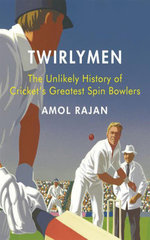Twirlymen
David Mutton |Published: 2011
Pages: 400
Author: Rajan, Amol
Publisher: Yellow Jersey Press
Rating: 5 stars

Twirlymen, Amol Rajan’s debut book, with its combination of original insight, detailed research, and hearty soul, is a triumphant history of spin
Like its closest comparison, David Frith’s The Slow Men, at its core are sketches of the great spinners in approximate chronological order. From Lumpy Stevens to Ajantha Mendis these potted biographies are thorough (for example, I did not know that Tony Lock had problems with his bent arm because of a winter netting under low roof beams) and include excellent technical explanations detailing how each bowler exerted spin on the ball.
The book is, though, more than mere descriptions of the masters. Rajan has written a history of the concept of spin bowling rather than just its practitioners. He traces its progress, continuity and evolution, starting with the underarm bowlers on uneven tufts of lands all the way to carrom ball. The birth stories of the various deliveries are told alongside their dissemination, and in the process various legends behind the birth of the googly and flipper are dismantled. Bowler by bowler a picture develops of an evolution that, unlike batting or fast bowling, is still ongoing.
Twirlymen is not perfect; some of the distinctions between time periods seem somewhat arbitrary – was Sydney Barnes in “the First Flourish” or a “Swift Pioneer”? – but it succeeds in showing how the tricks of the trade were passed down and built upon by each succeeding generation. Indeed it is a testament to Rajan’s skill that he has corralled tidbits from the lives of hundreds of spinners, analyzed their actions and successfully wrapped it in an overarching theory. That the final result is not overly academic, unduly epic or simply unreadable is thanks both to his grace as a writer and a passion for the subject that shines off each page.
We learn almost as much about the author as his subject. In a charming introduction Rajan informs us that he dedicated himself to becoming a leg-spinner after seeing Warne’s infamous delivery to Gatting in 1993 and because “the generosity of my boyhood girth equipped me only for a form of bowling wherein my approach to the crease would be an amble rather than a sprint.” He made it to the Surrey youth ranks but injury prevented a potential career in the game. If this is, as Rajan write, an “extended apology, mainly to the cricketer I might have been” it is both an exceptionally beautiful one and also tenderly optimistic.
Whereas The Slow Men, published in 1985, was an elegy for what was then a lost craft, Twirlymen is a celebration of the revitalization of spin bowling. Although not intended as a manual it is a call to action of sorts, with diagrams of various deliveries and detailed descriptions of mystery balls. As such it acts as a helpful love letter and an intellectual affirmation for anyone intent on breaking into the brotherhood of spin bowlers.






Leave a comment